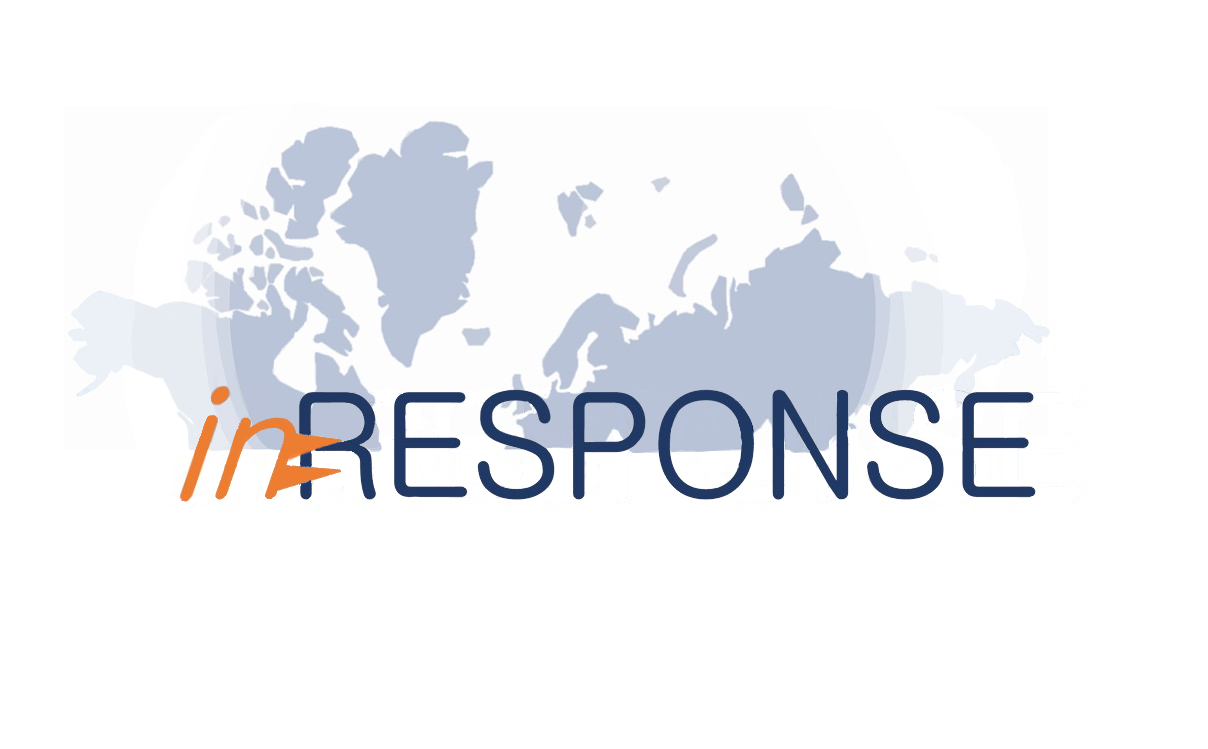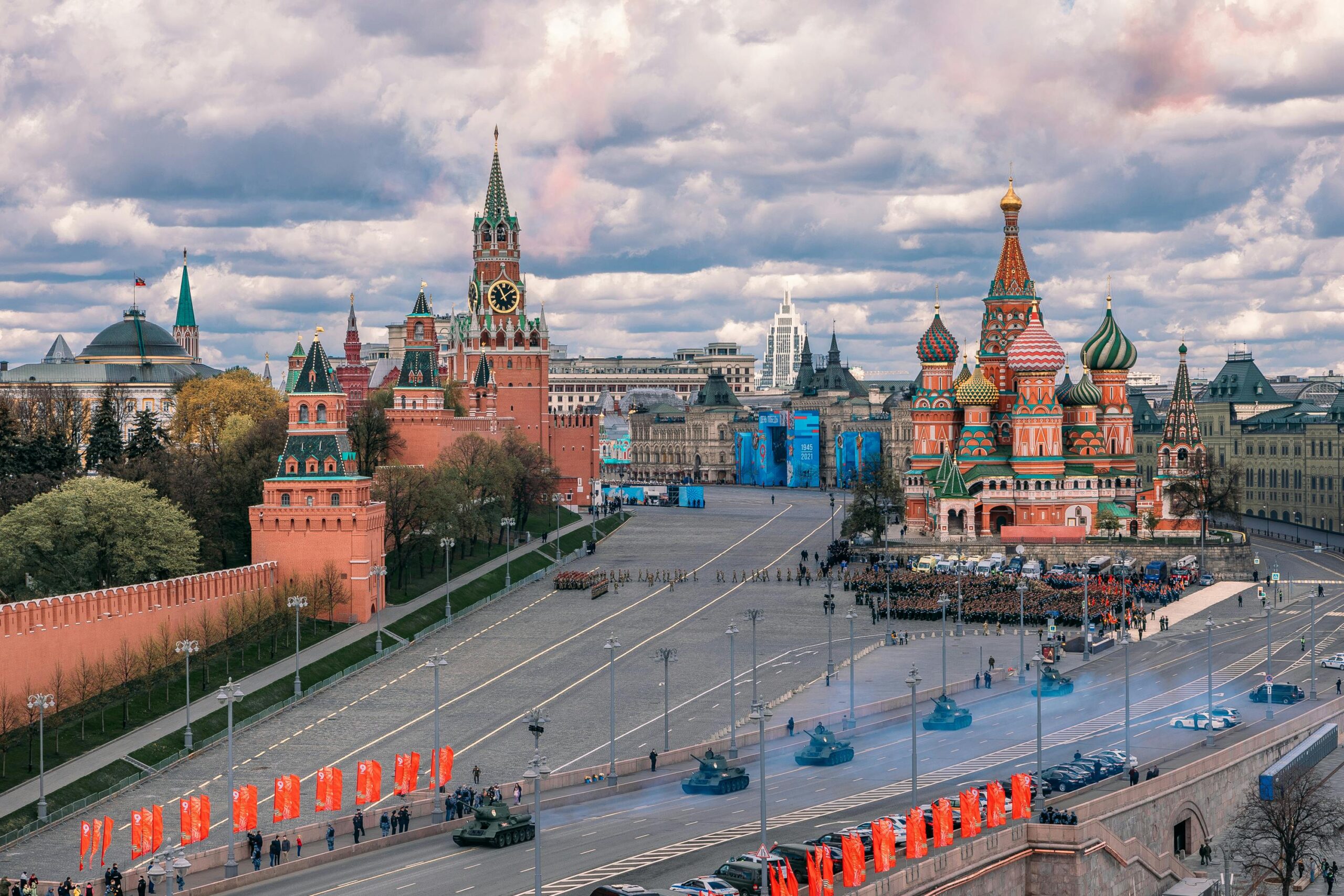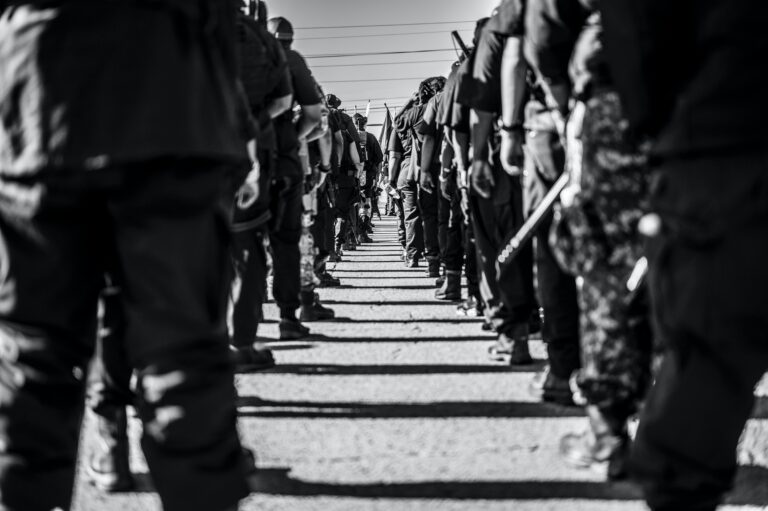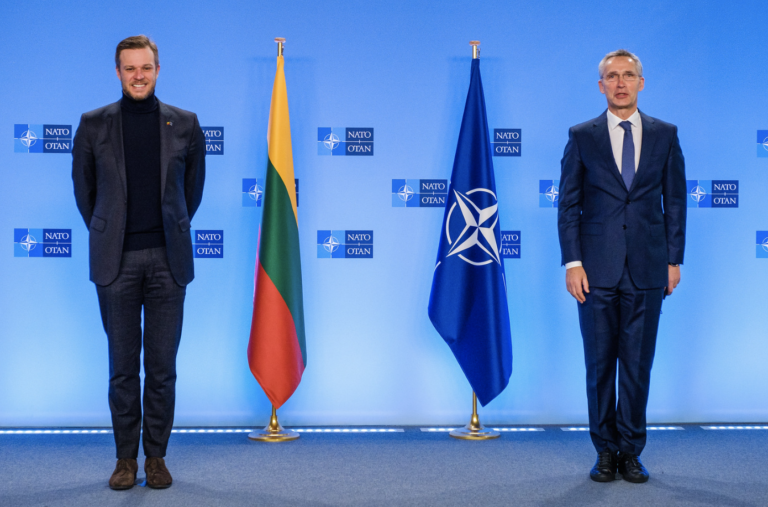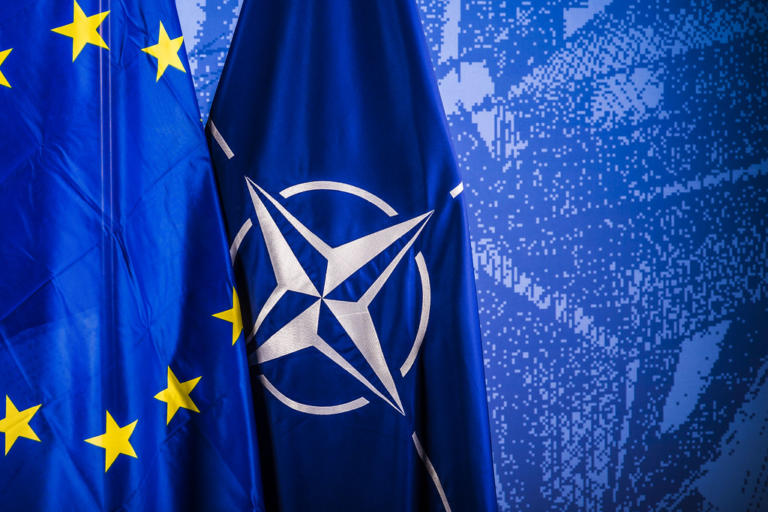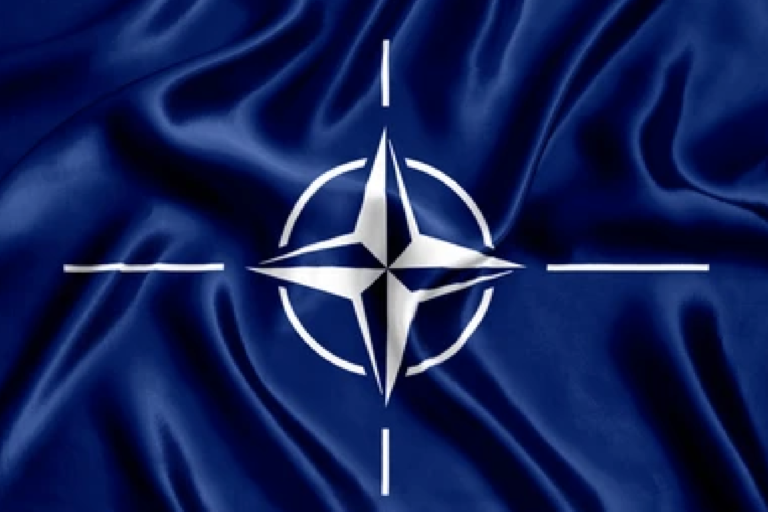Reshaping Security: The Impact of Russia’s Invasion into Ukraine on Military Expenditures in Eastern Europe and Central Asia
by Cecilia Duncan, inRESPONSE Researcher
The Russian invasion of Ukraine has upset the security order across Eastern Europe and Central Asia. Russian President Vladimir Putin ordered the invasion in February 2022 to expand Russian territorial gains and sever Ukraine’s ties with the North Atlantic Treaty Organization (NATO). This “special military operation” is in contravention of the 1975 Helsinki Accords and the Charter of the United Nations, which both established norms of the sovereignty and territorial integrity of European nations. The uncertainty that the invasion has generated about the continent’s stability has led many states, especially European Union (EU) and North Atlantic Treaty Organization (NATO) members, to increase their defense spending and military procurement. Military expenditures have also risen across the board in most non-EU and non-NATO countries in Eastern European and Central Asian countries neighboring Russia and Ukraine.
We have compiled data from the Stockholm International Peace Research Institute (SIPRI) on countries’ military expenditures in constant (2022) US$ in the years 2021 – 2023. Our data represents nine Eastern European and Central Asian countries: Armenia, Azerbaijan, Belarus, Georgia, Kazakhstan, Moldova, Russia, Tajikistan, and Ukraine (Table 1).
Out of the nine countries, the largest increases in defense expenditure since 2022 of course took place in Ukraine and Russia. Table 1 illustrates that Ukraine’s defense budget skyrocketed by over 800% as a response to the invasion. Russia’s 60% increase seems moderate in comparison; however, it reveals the long-term planning behind the invasion in 2022 as Putin has built up his military gradually over time since 2014.
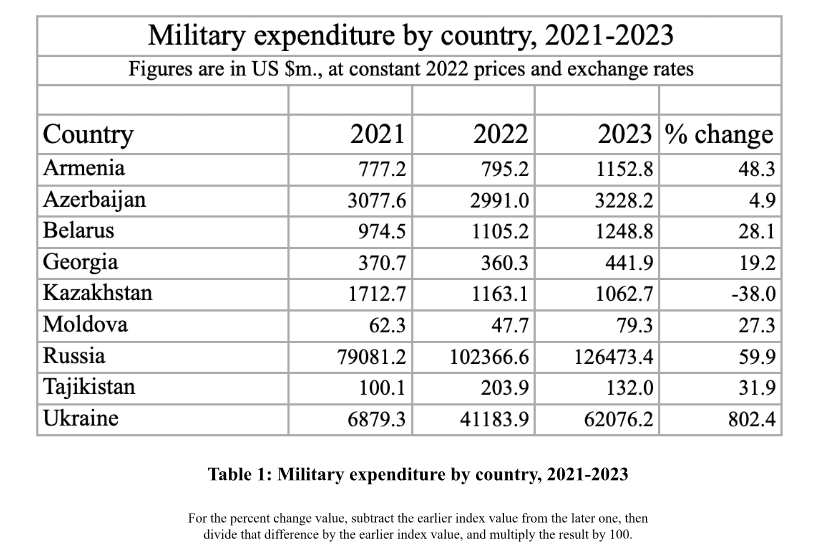
Other countries’ increase in military expenditure since 2022 is varied. Table 1 illustrates a significant increase (an increase of over 3-5%) in spending, between 30% to 50% in most countries. For example, Armenia and Tajikistan increased their spending by over 30%, showing their shifting security priorities. Belarus, who, like Ukraine, shares its Western border with Russia, has increased spending by 28.8%. Belarus has not directly involved itself in the conflict, instead providing logistical support to Russia.
In contrast, Kazakhstan has experienced military divestment since 2022 with a sharp decrease of 38% in spending. This is curious on various levels. The authoritarian country experienced a popular uprising in 2022 that would warrant increased military expenditure to keep the population in check. Moreover, as traditional Russia’s allies Kazakhstanis could opt to help Russia in its war effort, similar to Belarus but instead decided to adopt a neutral stance on the conflict.
While all countries are affected by the Russian invasion, how each country’s military allocates its budget is ultimately a reflection of a complex mix of domestic and foreign policy issues. Some have prioritized local conflicts, while others have increased spending to defend against or even appease Russia. The following case studies illustrate unique approaches to foreign policy across Eastern Europe and Central Asia.
Foremost, the increased military spending in Armenia and Azerbaijan is primarily the result of the territorial dispute between the two countries over the Nagorno-Karabakh region, which is located within the internationally recognized borders of Azerbaijan but has a 95% ethnically Armenian population. The conflict had been relatively quiet after a ceasefire in 1994 but reignited dramatically in 2020, as Azerbaijan launched a large-scale offensive to reclaim the territory it had lost in the decades prior. Azerbaijan finally recaptured the region in September 2023 and now asserts full government control, since the de-facto Nagorno-Karabakh’s authorities dissolved in January 2024.
Armenia increased its spending by a staggering 48.3% over the past two years to counter Azerbaijan’s advances. Nonetheless, Azerbaijan’s larger military budget of $3228 million in 2023 (compared to Armenia’s $1153 million) reflects its stronger economic resources and the strategic importance it places on the conflict. Peace talks are now ongoing but Armenia and Azerbaijan’s increasing military spending and continuous clashes reflect how tense the situation remains on the ground.
Armenia’s increased spending needs to also consider the deterioration of relations with Russia, on which Yerevan has historically relied for its security. The conduct of Russian peacekeeping forces in Nagorno Karabakh and the refusal by the Collective Security Treaty Organization (CSTO), the Russia-led security organization of which Armenia is a member, to respond to Azerbaijan’s incursions led Yerevan to question its security system. The increase in spending is thus likely to be part of the country’s attempt to revise and diversify its security and defense strategy in a period of strong regional tension and growing geopolitical uncertainty.
Other countries, like Moldova, increased their spendings precisely to fend off the threats emerging from the war in Ukraine and Russia’s aggressive foreign policy in its near abroad. Chisinau is concerned that the Kremlin might be planning to extend the war into Moldova, especially through the breakaway region of Transnistria, where roughly 1500 Russian troops have been stationed since the war in the 90s. Furthermore, Russia has launched a hybrid warfare against Moldova, which intensified in light of the upcoming presidential election and referendum on joining the EU. Cyber-attacks and disinformation campaigns are part of the Kremlin’s broader strategy to undermine public confidence in the government and its pro-European trajectory. The Moldovan government has increased military spending from $47.7 million in 2022 to $79.3 million in 2023, which has gone toward tightening border controls and modernizing the armed forces. Although significant in percentage terms (27.3%), Moldova’s spending is minor in absolute terms compared to the expenditures of larger powers in Figure 1. This highlights the country’s vulnerability, which Russia continues to exploit, and its need for international support.
Lastly, other countries’ spending reveals a more complex foreign policy plan. Georgia’s prime location in the South Caucasus makes it vulnerable to Russian influence and aggression. Georgia was itself engaged in a war with Russia in 2008 that concluded with Tbilisi losing the control over the self-declared republics of Abkhazia and South Ossetia. Since the dissolution of the Soviet Union, Georgia’s Euro-Atlantic ambitions have made the relations with Russia very tense. The Kremlin views Georgia’s pro-Western trajectory as a threat to its sphere of influence and has run disinformation campaigns to discredit the country’s Western alliances. Nonetheless, left without clear security guarantees from NATO, in the last decade the country’s government has attempted to balance relations between its Western allies and Russia. This approach continued in the aftermath of the war in Ukraine. In the absence of NATO security guarantees, Georgia’s military expenditures increased by 20% between 2022 and 2023. Some view this spending, however, as a simple cover for a geopolitical reorientation of the country toward Moscow.
In conclusion, the significant changes in military expenditures across Eastern Europe and Central Asia demonstrate the profound impact that Russia wields over its neighbors. The data reflects a region-wide re-evaluation of security priorities, driven by the volatility and uncertainty brought about by the war in Ukraine. The variation in spending among different countries points to a complex geopolitical landscape where national security strategies are influenced by both regional tensions and internal political dynamics. Yet, these trends in military spending all testify to the impact of Russia’s invasion on the regional security order and highlight the risk of prolonged instability and potential for further conflicts. The data thus underscores the importance of international diplomatic efforts in a moment of strong precariousness for the entire post-Soviet space.
The views, thoughts, and opinions expressed in the blog posts belong solely to the authors, and are not necessarily representative of the Institut Barcelona d’Estudis Internacionals (IBEI) nor the Spanish Ministry of Science and Innovation. The content provided through our blogs is for informational purposes only. Readers are encouraged to consider the context and research behind the viewpoints shared within each blog post.
